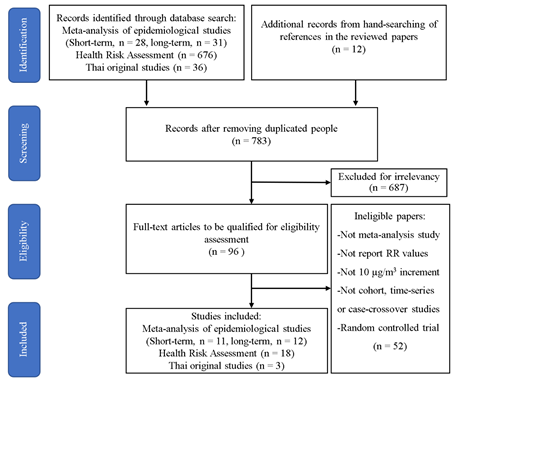Health Impacts from PM2.5 Exposure Using Environmental Epidemiology and Health Risk Assessment: A Review
Main Article Content
Abstract
Exposure to PM2.5 has been known to cause a variety of serious health consequences. Quantifying and investigating the health effects of PM2.5 pollution are imperative to understand and collect scientific evidence for supporting policies and associated actions. In this paper, we reviewed published environ-mental epidemiological studies and health risk assessments evaluating the health impacts of PM2.5 exposure in the PubMed database to identify the attributes of each method and aggregate the health impact results to perform analyses and summaries. Forty-two studies were identified after applying our search strategy, inclusion, and exclusion criteria. The epidemiological studies found an increased risk of several diseases from short- and long-term exposure, such as cardiovas-cular and respiratory diseases, lung cancer, stroke, pneumonia, depression, and diabetes. However, several conditions remain to be explored as the associations remain unclear, such as asthma, bronchitis, breast cancer, Parkinson’s disease for long-term exposure, chronic obstructive pulmonary disease, stillbirth, and hypertension for short-term exposure. Health risk assessment (HRA) studies at a global scale found more than 4 million deaths from diseases associated with PM2.5 exposure. These studies also emphasized the importance and benefits of health guidelines that demonstrated to help avoid the number of fatalities significantly, especially guidelines from the World Health Organization (WHO) that showed the highest benefit. HRA studies in Thailand also showed that the country's air quality needs to be improved to avoid deaths and hospital admission cases. We also found that cohort studies for the Thai population are required to improve the quality of data and limit overestimation from using global estimates. Finally, the benefits and limitations of each study approach were collated to assist future studies in determining the most suited instruments for their purposes.
Article Details

This work is licensed under a Creative Commons Attribution-NonCommercial 4.0 International License.
Published articles are under the copyright of the Applied Environmental Research effective when the article is accepted for publication thus granting Applied Environmental Research all rights for the work so that both parties may be protected from the consequences of unauthorized use. Partially or totally publication of an article elsewhere is possible only after the consent from the editors.

